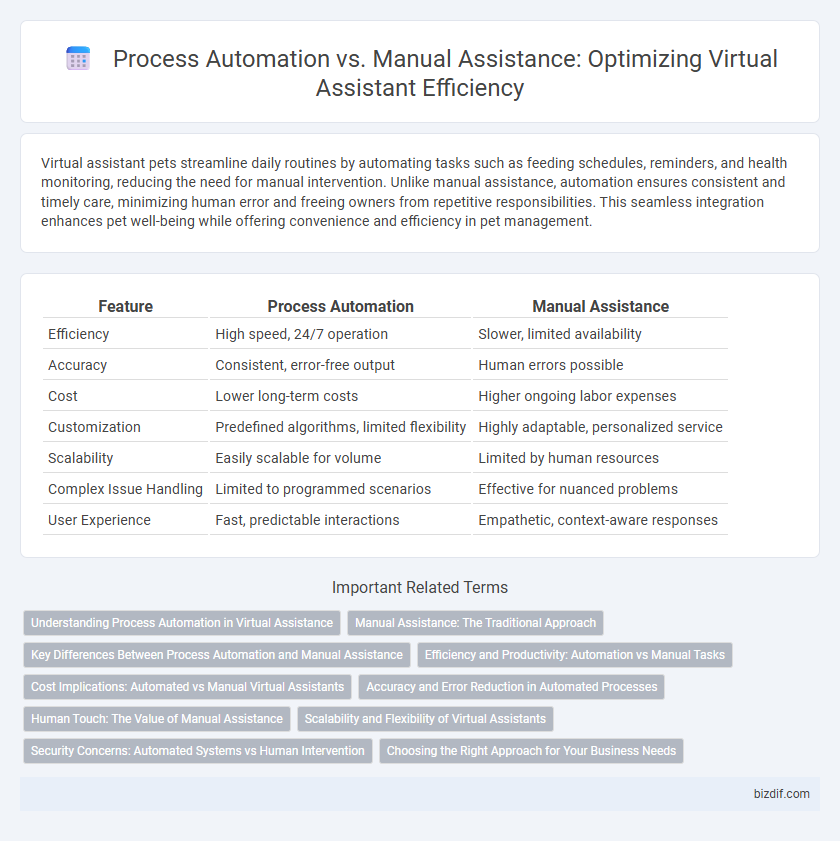Virtual assistant pets streamline daily routines by automating tasks such as feeding schedules, reminders, and health monitoring, reducing the need for manual intervention. Unlike manual assistance, automation ensures consistent and timely care, minimizing human error and freeing owners from repetitive responsibilities. This seamless integration enhances pet well-being while offering convenience and efficiency in pet management.
Table of Comparison
| Feature | Process Automation | Manual Assistance |
|---|---|---|
| Efficiency | High speed, 24/7 operation | Slower, limited availability |
| Accuracy | Consistent, error-free output | Human errors possible |
| Cost | Lower long-term costs | Higher ongoing labor expenses |
| Customization | Predefined algorithms, limited flexibility | Highly adaptable, personalized service |
| Scalability | Easily scalable for volume | Limited by human resources |
| Complex Issue Handling | Limited to programmed scenarios | Effective for nuanced problems |
| User Experience | Fast, predictable interactions | Empathetic, context-aware responses |
Understanding Process Automation in Virtual Assistance
Process automation in virtual assistance leverages AI and machine learning to perform repetitive tasks such as scheduling, data entry, and customer support without human intervention. This technology enhances efficiency by reducing errors and response times while enabling virtual assistants to handle complex workflows seamlessly. Understanding process automation allows businesses to optimize resource allocation, increase scalability, and improve overall productivity compared to traditional manual assistance.
Manual Assistance: The Traditional Approach
Manual assistance relies on human intervention to handle tasks, offering personalized support and adaptability in complex scenarios that automation may struggle to interpret. This traditional approach involves direct communication, decision-making based on contextual understanding, and handling exceptions that process automation systems often miss. While less scalable, manual assistance excels in situations requiring empathy, nuanced judgment, and real-time responsiveness.
Key Differences Between Process Automation and Manual Assistance
Process automation leverages software and artificial intelligence to execute repetitive tasks efficiently, reducing human error and increasing productivity. Manual assistance relies on human intervention for decision-making, customization, and handling complex or nuanced scenarios that automation may not address effectively. Key differences include speed, scalability, consistency, and the requirement for human judgment and adaptability in manual processes versus the streamlined, rule-based execution in automated systems.
Efficiency and Productivity: Automation vs Manual Tasks
Process automation in virtual assistants significantly enhances efficiency by executing repetitive tasks faster and with fewer errors compared to manual assistance. Automated workflows reduce human intervention, allowing for consistent task execution and freeing up employees to focus on higher-value activities. This shift boosts overall productivity by minimizing delays and maximizing resource allocation within business operations.
Cost Implications: Automated vs Manual Virtual Assistants
Automated virtual assistants significantly reduce operational costs by handling repetitive tasks without the need for continuous human intervention, leading to lower labor expenses and increased scalability. In contrast, manual virtual assistants incur higher costs due to salaries, training, and potential errors that require human oversight. Businesses benefit from automation by minimizing overhead while maintaining efficient customer support and workflow management.
Accuracy and Error Reduction in Automated Processes
Process automation significantly enhances accuracy by minimizing human errors commonly found in manual assistance tasks. Automated virtual assistants utilize machine learning algorithms and predefined workflows that ensure consistent and precise execution of repetitive processes. This systematic approach leads to a substantial reduction in operational errors and improved overall efficiency.
Human Touch: The Value of Manual Assistance
Manual assistance delivers a personalized human touch that process automation often lacks, enabling nuanced understanding and empathy in complex interactions. Human agents can adapt dynamically to unique customer needs and emotional cues, providing tailored solutions beyond algorithmic responses. The value of manual assistance lies in its ability to build trust and satisfaction through genuine, context-aware communication.
Scalability and Flexibility of Virtual Assistants
Virtual assistants significantly enhance scalability by handling multiple tasks simultaneously without the limitations of human fatigue or availability. They offer unparalleled flexibility, seamlessly adapting to various workflows and integrating with numerous software platforms to meet evolving business needs. Unlike manual assistance, automated processes reduce error rates and operational costs while enabling rapid scaling to support growing customer bases.
Security Concerns: Automated Systems vs Human Intervention
Automated virtual assistant systems employ advanced encryption protocols and continuous monitoring to mitigate security risks, reducing human error vulnerabilities present in manual assistance. Human intervention, while offering adaptability and judgment, poses increased risks of insider threats and data mishandling due to inconsistent security practices. Balancing automation with secure human oversight ensures optimized protection of sensitive information in virtual assistant workflows.
Choosing the Right Approach for Your Business Needs
Process automation streamlines repetitive tasks by leveraging artificial intelligence and machine learning, reducing errors and increasing efficiency in customer service and data management. Manual assistance offers personalized support for complex or nuanced issues requiring human judgment and empathy, essential in industries like healthcare and legal services. Evaluating your business needs based on task complexity, volume, and required interaction quality ensures selecting the most effective balance between automation and human intervention.
Process Automation vs Manual Assistance Infographic

 bizdif.com
bizdif.com